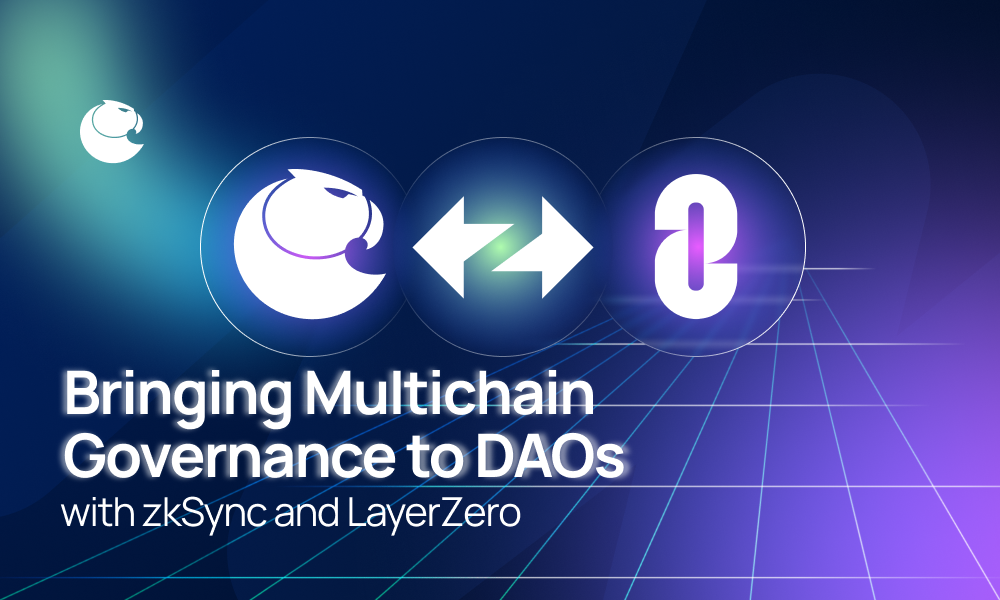Introducing multichain governance to DAOs using zkSync and LayerZero

Multichain governance has arrived in Aragon OSx! The new plugin leverages the LayerZero protocol for cross-chain messaging and the zkSync Era rollup for cheap and secure voting. The code is still being audited, but you can already take a look at it here.
This plugin allows DAOs to manage assets and permissions across the EVM chain through one mainnet DAO smart contract. This is a significant step forward for protocol governance distributed across chains.
Here’s how the governance of a multichain DAO works from proposal to execution.
- Use tokens across chains to create custom censuses. Create custom censuses using governance tokens across multiple chains using LayerZero’s Omnichain Fungible Token (OFT) standard.
- Vote for zkSync at low cost: Once the census is created, members can vote on a consensus on zkSync for a small fee.
- Execute tasks simultaneously across multiple chains. After voting, users can leverage the Aragon OSx permission management system to execute actions programmed on proposals from multiple chains simultaneously in the mainnet DAO.
The architecture is diagrammed as follows:
The plugin code is open source and currently being audited. If you are interested in using this design, Contact us here About custom builds The plugin will be running in the no-code Aragon app in the new year.
This particular multichain governance design is not possible without Aragon OSx’s modular permission management system, which allows DAO contracts to simply grant and revoke permissions to external contracts.
Here’s what the plugin can do and why it’s exciting for the future of on-chain governance.
Execute tasks simultaneously on all chains
Operations can be executed on the mainnet as well as on any chain where a proxy DAO is deployed on the main DAO. This provides ultimate governance flexibility, allowing you to adjust parameters and send assets to the exact chain you need.
If you want to run multiple tasks simultaneously, you don’t need to create multiple proposals to run the tasks. Save DAO time and resources by executing all tasks in a single proposal. This is thanks to the permission management system at the heart of Aragon OSx.
Build a census with tokens on any chain
With the multichain governance plugin, voting power is no longer fragmented. DAO members can hold governance tokens on any EVM chain and be counted in the same voting census in zkSync.
The plugin leverages LayerZero’s Omnichain Fungible Token Standard (OFT) to extend the functionality of governance tokens, allowing token holders to vote for zkSync regardless of the chain on which the token originated.
You are not limited to fungible tokens. You can also use various tokens like NFTs in your voting census. This provides more membership options as members can hold different tokens on different chains and still have their voting rights counted. As long as the token follows the voting standards, it can be used in the wrapper.
Vote for zkSync to save gas costs and increase token participation
This plugin frees DAO members from expensive mainnet voting. All voting takes place in zkSync, so it costs only a fraction of the mainnet voting cost.
This allows token holders to save significant gas costs when voting. It can also increase token participation as members are more likely to vote if they don’t have to pay. Higher token participation can improve the DAO’s resistance to capture. This is because it is more difficult for a single entity to purchase tokens and pass an offer unilaterally.
Increase voter participation with Layer 2 scalability while enjoying the security and liquidity benefits of Layer 1.
Multichain governance provides the advantages of layer 1 and layer 2 blockchains. Your DAO will have the security and liquidity benefits of being deployed on the Ethereum mainnet, along with the scalability of low-cost voting at Layer 2.
“It’s clear that Ethereum is now expanding through rollups, but we’re left with the question of connecting and managing accounts across Ethereum. “Through our multi-chain governance work, we enable the scaling of Ethereum by distributing liquidity and offloading some transactions to L2, while still ensuring the protocol remains on the mainnet.”
— Carlos, CTO
We are proud to integrate with zkSync and LayerZero to make multichain governance a reality. Here’s how it all fits together.
zkSync: A forward-thinking zkEVM with a mission to expand freedom for all.
All voting in the new multichain governance plugin is done in zkSync, a rollup leveraging zero-knowledge proofs.
zkSync is hyperscalable to L2 with the highest total number of transactions and is secure as it inherits 100% of Ethereum’s security. zkSync’s low-cost transactions and emphasis on security make it an ideal venue for conducting DAO voting.
zkSync’s technology also supports paymasters, allowing DAOs to pay for voting gas for their members.
LayerZero: Omnichain Interoperability Protocol
LayerZero supports cross-chain messaging leveraged by the multichain governance plugin, providing novel and unparalleled ease of governance across chains in a gas-efficient manner. This is done using the widely adopted Omnichain Fungible Token (OFT) standard.
LayerZero’s Omnichain Fungible Token (OFT) standard enables native multichain assets. It wraps all tokens to become OFT and can be used on any EVM chain. Instead of sending your assets to a bridge, receiving new assets created by that bridge, and then trusting that bridge’s security to keep your assets safe, OFT is the underlying asset.
Here’s how it works: If you want to wrap a token, the token on the original chain is burned and a new token is created on the target chain. LayerZero relays cross-chain messages to complete this task. If you want to send tokens back to the original chain, the process is reversed. That means burning the tokens and then reissuing them on the original chain.
Combining these two industry-leading technologies with Aragon OSx’s modular permission management system enables multichain governance.
Aragon OSx: DAO framework with security and modularity at its core
At the heart of the multi-chain design is Aragon OSx, a modular, adaptive protocol that can manage permissions for external contracts and addresses. Here’s why Aragon OSx is perfect for building multichain governance:
- Flexible permission management system: The permission management system at the core of the protocol is flexible enough to add cross-chain conditions using LayerZero.
- Independent protocol design: Aragon OSx’s design does not conflict with the wide selection of different L2s. Because OSx is simple and unbiased, it’s easier to plug and play different EVM chains.
- Clonable plugin system: The plugins you build can be replicated across the chain, so there’s no need to redo development.
- Powerful default plugin contract: The base contract handles most of the logic, making development easier.
You can learn more about Aragon OSx here.
We live in a multichain world. Because a thriving rollup ecosystem has emerged as a solution to Ethereum scalability, the protocol needs a way to manage assets and permissions across the chain.
Multichain organizations now have the answer to managing fully on-chain. The multichain governance plugin allows you to seamlessly manage protocols deployed across chains without the security risks of deploying multiple DAOs or fragmenting members’ voting power. With lower gas fees for voters to encourage participation, token holders will not face any barriers to participation.
Powerful multichain governance allows organizations to run their entire end-to-end governance stack on-chain, leveraging the benefits of being built on trustless, permissionless, and censorship-resistant technologies.
Multichain governance for multichain protocols will forever change the way we manage on-chain.
The multichain governance plugin is currently being audited, but you can check out the codebase here. If you are interested in implementing this plugin in your own DAO, please fill out this form and we will get back to you! Or, if you’re attending Devconnect, find a team member to chat! We will have a booth at the Stake Summit and attend the events listed here.



